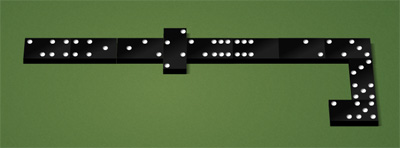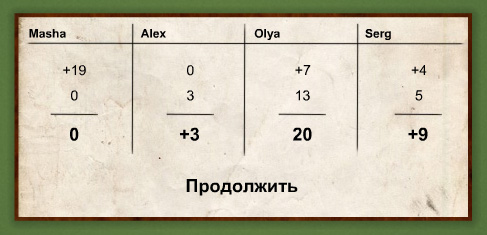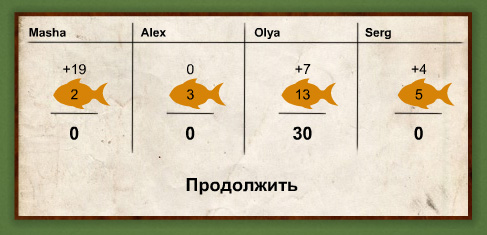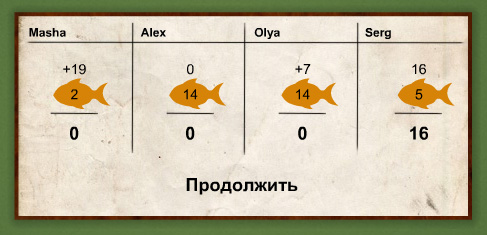Help on games, interface, games rules. Domino Goat – Game Rules
Rules of the game in Domino: Goat
Bones with the same meaning on both halves (0-0, 1-1, 2-2, 3-3, 4-4, 5-5 and 6-6) are called dubs.
The game participates from two to four people.
Stroke Game
The game in the "goat" is divided into rounds.
At the beginning of each round, players take blind bones blindly.
If a player has five and more doubles or six and more bones with a repeating value, bones are relocated.

If less than four people take part in the game, then unnecessary, remaining after the bone passing, moved to the edge of the table. These bones are called "Bazaar".
The first move in the first round belongs to the player who has a double 1-1 on his hands. It is from this dubl who is obliged to go to the participant. If no one does not have such a duplicate, then one of the participants who have a double 2-2 in his hands. And so on to the bone 6-6. If any of any of the participants and bone 6-6, then the first move from the double 0-0. If there are no doubles at all, then the move from the bone is 5-6, and so on, descending the bone values.
The move is transmitted clockwise. Each next player must put the bone, the value of which is equal to the value of the bone on the side of contact already posted on the table.
If the player has no suitable bones, then he "goes to the bazaar", that is, blindly pulls on one of the extra bones pending on the edge. So continues until the player finds the bone with the necessary value. In the event that there is no "bazaar" or it ended, but not a single bone approached, the player "knocks", that is, she misses the move. All the bones taken at the "bazaar" remain in his hands.
The player has no right to miss the move if he has a bone on his hands you can play.
In one course, the player can put only one bone.
The round ends when someone from the players in their hands does not have bones, that is, the player "came out", or when the player puts "fish". The first move in the next round makes a "released" player, or "Fisherman", that is, the one who put "fish". It can walk from any bone.

"Fish" call a situation in which all players have bones in their hands, but do not have the opportunity to walk. Such a situation is possible when all six (not counting a double) of knuckles with the same value and both ends of the chain are closed with the same value on the table.
For example, bones 1-2, 2-6, 0-2, 2-3 are already laid on the table. The chain on one side ends with a bone of 2-4, and on the other to the bone 5-2. This is a fish".
If a double 2-2 was played, as shown in the picture, and it would be on the "bazaar" or on someone from the players, it would still be "fish".
If the round ends not by fish, but simply the "output" of one of the participants who saved from all his bones, then the remaining players open their bones and consider the amount of points of these bones.
Counting points
Если у игрока по итогам раунда на руках остается одна единственная кость 0-0, то она считается за 10 очков. Все остальные кости считаются по номиналу.
Если сумма костей у игрока не превышает 12 очков, то это число «запоминается» на следующий раунд за игроком. Если в следующем раунде игрок снова наберет сумму в 12 или менее очков, то новая сумма плюсуется со старой «запомненной» и переходит в «запомненную» сумму на следующий раунд. Если игрок «вышел», то все его «запомненные» очки обнуляются.
Если игрок набрал в раунде более 12 очков — то он открыл свой счет в партии. Если у игрока на момент открытия счета были «запомненные» очки, то они плюсуются к набранной сумме. С момента открытия счета очки не «запоминаются» и любое, даже самое малое, количество очков набранных в раунде будет сразу же плюсоваться на счет игрока.
![]()
Все набранные или «запомненные» игроками очки отображаются на экране рядом с логином. «Запомненные» очки отображаются желтым цветом. Перед суммой очков стоит знак «+»
![]()
Открытый счет отображается красным цветом, без знака «+»
Рассмотрим систему подсчета очков на примере когда один из игроков «released»

Верхнее число в таблице — очки набранные в предыдущих раундах.
Число посередине (над чертой) — сумма, набранная в текущем раунде.
Число под чертой — итоговая сумма очков.
В рассматриваемом нами примере игрок Masha «вышла», так как набрала 0 очков. До этого раунда у нее было 19 «запомненных» очков. Так как игрок «вышел», его запомненные очки обнулились и итоговая сумма равна нулю.
Игрок Alex не имел на начало раунда никаких очков, но в текущем раунде набрал 3 очка. Поскольку 3 очка меньше 12 и игрок не открыл счет, то он получил в результате +3 «запомненных» очка.
Игрок Olya на начало раунда имела +7 «запомненных» очков. В текущем раунде она набрала 13 очков и таким образом открыла счет. В результате она получила 13 + 7 = 20 очков.
Игрок Serg имел на начло раунда +4 «запомненных» очка. В раунде он набрал 5 очков. Таким образом счет он не открыл, но «запомненные» очки суммировались. Теперь у него +9 «запомненных» очков.
Если раунд заканчивается «рыбой», то существует несколько вариантов правил, по которым идет подсчет очков. При создании заявки на игру вы сможете задать один из этих вариантов, изменив соответствующий параметр. Теперь рассмотрим каждый из них на примере.

Первый вариант правил назовем «рыба на всех" В этом варианте подсчет очков ничем не отличается от обычного механизма подсчета. Единственное отличие в том, что каждый игрок в этом раунде набрал очки, так как «вышедшего» игрока нет.
Обратим внимание на таблицу. В средней строчке таблицы нарисованы иконки «рыбы». Они говорят нам о том, что раунд закончился «рыбой».
Второй вариант назовем «рыба на одного" В этом варианте подсчитываются не только очки каждого игрока, но и сумма очков всех костей оставшихся на руках у игроков.As a result of scoring, the player who scored the most points in this round is found. It is to him that the sum of the points of all the bones remaining in the hands of the players is added. Let's look at an example:

In this round, the player with the nickname Masha scored 2 points, Alex – 3 points, Olya – 13 points and Serg – 5 points. So the total points scored by the players is 23.
Olya scored the most points in the round, she has 13. So, it is she who receives the total amount of points scored by all players. This is 23 points. In addition, she had "remembered" 7 points, which are added to the amount when opening an account. As a result, Olya gets 30 points. Let's pay attention to the fact that the memorized points of other players have been reset.
Another situation is also possible, when several players score the same maximum number of points. For example:

Players Alex and Olya scored the most points. Each of the bottom 14. In this case, the round is considered to be played "draw". The entire amount of fish (35 points) goes to the next round.

This situation is also displayed on the screen. In this case, a fish icon appears under the timer. It displays the number +35, that is, the amount that has passed over the fish from the last round.
In this case, in the next round, regardless of its outcome (whether it ends with a regular exit or a “fish”), the player who scored the maximum number of points will receive, in addition to his account, the entire amount transferred from the last round.
If the round again ends with a “fish” and the situation with the same maximum number of points repeats again, then the results of the new round will be added to the memorized amount and the total memorized amount for two rounds will go to the next one.
This will continue until there is one player who has scored the maximum number of points.
Game results
The game is considered over as soon as one of the players scores 101 or more points. A player who scores 101 or more points in total according to the results of the rounds is considered a loser, that is, he becomes a “goat”.
Calculation of the rating for the game "Goat"
The losing player does not receive rating points.
All other players receive rating points. The rating is calculated according to the following formula:
(100 − [sum of player points]) / 10
with rounding according to the rules of mathematics, but with the condition that the result cannot be less than 1 point.
For example:
Masha scored 25 points.
We substitute the value in the formula, we consider: (100 – 25) / 10 = 7.5.
Round up = 8.
Thus, according to the results of the game, Masha's rating will increase by 8 points.
If the game is interrupted by a timeout, then the player who left the game by timeout does not receive rating points.
All other players in this case receive points to the rating. The rating is calculated according to the following formula:
([points of the player who was eliminated by timeout] – [the sum of the points scored by the player]) / 10
with rounding according to the rules of mathematics, but with the condition that the result cannot be less than 1 point.
For example:
Alex scored 32 points and retired along the timeout. It does not get rating glasses.
Masha scored 30 points, despite the fact that the game was interrupted along the timeout, but not by its fault.
We substitute the value in the formula, we believe: (32 – 30) / 10 = 0.2
Round = 0.
But we remember that the result cannot be less than 1 points. Thus, the Masha player rating will rise by one.
Olya scored 13 points, despite the fact that the game was interrupted along Taimaut, but not by her fault.
We substitute the value in the formula, we believe: (32 – 13) / 10 = 1.9
Round = 2 points.
Thus, the Olya player rating on the results of the game will increase by 2 points.










